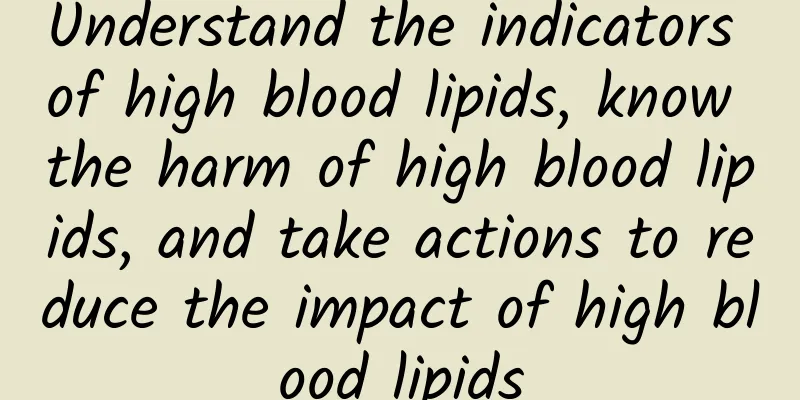Understand the indicators of high blood lipids, know the harm of high blood lipids, and take actions to reduce the impact of high blood lipids

|
With the development of social economy, people's living standards have been unprecedentedly improved, and their living habits have also undergone tremendous changes, accompanied by the "four highs" problem, namely high blood pressure, high blood lipids (clinically often called hyperlipidemia), high blood sugar and high uric acid. Among them, high blood lipids are the most common. According to statistics, about 400 million Chinese people have abnormally high blood lipids, which poses a major threat to personal health, family life and public health. Hyperlipidemia has a damaging effect on multiple organs and tissues of the human body. Understanding the harm of hyperlipidemia, understanding it and preventing it are of great significance to promoting personal health and family happiness. Understanding blood lipid indicators The main blood lipid examination items include triglycerides (TG), total cholesterol (TC), low-density lipoprotein cholesterol (LDL-C) and high-density lipoprotein cholesterol (HDL-C). For total cholesterol, less than 200 mg/dL (milligrams per deciliter) is an ideal level, 200-239 mg/dL is borderline high, and greater than 240 mg/dL is a high cholesterol level. For low-density lipoprotein cholesterol, less than 100 mg/dL is the optimal level, 100-129 mg/dL is normal/near-normal level, 130-159 mg/dL is borderline high, 160-189 mg/dL is high, and greater than 190 mg/dL is very high. For HDL cholesterol, a good level is greater than 40 mg/dL (for men) or greater than 50 mg/dL (for women). For triglycerides, less than 150 mg/dL is a normal level, 150-199 mg/dL is borderline high, 200-499 mg/dL is high, and greater than 500 mg/dL is very high. Because high-density lipoprotein cholesterol has a protective effect on the cardiovascular system, the lower the LDL cholesterol, the better, and the higher the HDL cholesterol, the better. However, the actual situation is that low is high and high is low. The dangers of high blood lipids Long-term hyperlipidemia can cause damage to the vascular endothelium in multiple parts of the body, resulting in the deposition of excess lipid components in the blood vessels in the blood vessel walls, causing atherosclerosis, which can affect multiple parts and systems, causing dysfunction of multiple organs throughout the body. (I) Cardiovascular and cerebrovascular diseases. If hyperlipidemia is not controlled for a long time, it will lead to cardiovascular stenosis, thus inducing angina pectoris, and in severe cases, acute myocardial infarction may occur. If cerebral atherosclerosis occurs, it will lead to insufficient blood supply to the brain vessels, resulting in transient cerebral ischemia. In severe cases, it may also lead to large-area cerebral infarction, causing patients to have limb movement disorders, speech difficulties, and even life-threatening. (II) Digestive system diseases. Hypertriglyceridemia in hyperlipidemia can cause acute pancreatitis. Patients often experience symptoms such as acute upper abdominal pain, nausea, vomiting, and temporary hyperglycemia. Acute pancreatitis can also be complicated by infection and develop into peritonitis, acute respiratory failure, acute renal failure, etc., which can be life-threatening in severe cases. (III) Endocrine system diseases. Diabetic patients have insufficient insulin secretion, which leads to elevated blood sugar levels. Hyperlipidemia and blood sugar promote each other, making peripheral vascular disease very likely to occur. Therefore, patients need to take into account the treatment of hyperlipidemia while treating diabetes. In addition to damage to the above three systems, hyperlipidemia can also cause kidney damage resulting in glomerulonephritis, liver damage resulting in fatty liver, cholecystitis, gallstones, etc. Hyperlipidemia is a front-end disease. Its increase can cause great harm to the body and can affect or even cause pathology in almost all organs. Prevention of Hyperlipidemia The most important measure to prevent hyperlipidemia is to improve your lifestyle, such as a low-salt and low-fat diet, smoking cessation and alcohol restriction, regular physical exercise, adequate rest, a balanced mentality, etc. (I) Low-salt and low-fat diet. The World Health Organization recommends that the daily salt intake per person should not exceed 5g. In fact, the daily salt intake per person in my country is 8-15g, which is far more than the recommended amount by the World Health Organization. This does not include the invisible salt in condiments such as MSG and soy sauce, so it is necessary to reduce the intake of salt. In addition, eating a lot of fish and meat has become the norm for people's diet nowadays, and the calorie intake is seriously exceeded. It is recommended to eat more vegetables and fruits to reduce the total calorie intake. (II) Quit smoking and limit alcohol consumption. Tobacco is harmful to multiple tissues and organs of the human body. People who are addicted to smoking should quit smoking as soon as possible, and non-smokers should avoid any form of smoking (including secondhand smoke). Reduce alcohol intake. The "Dietary Guidelines for Chinese Residents (2022 Edition)" recommends that adult males should not drink more than 25g (equivalent to 60° alcohol content) per day, and women should not drink more than 15g. Patients with underlying diseases such as chronic liver disease and hypertension should absolutely abstain from alcohol. (III) Regular physical exercise. Regular physical exercise has a good promoting effect on human health. It is recommended to do at least 150 minutes of moderate-intensity exercise and 75 minutes of high-intensity exercise per week, such as long-distance running, playing ball, cycling, swimming, etc. In addition to the three preventive measures mentioned above, avoiding excessive stress, maintaining a good attitude, avoiding staying up late and ensuring adequate sleep are all helpful in preventing hyperlipidemia. I hope everyone will understand the dangers of hyperlipidemia and prevent it. If you find elevated blood lipids during a physical examination, or experience symptoms such as dizziness, headache, palpitations, and shortness of breath, you must go to the hospital for diagnosis and treatment in time. |
<<: How to use medicines safely through the “five steps”?
>>: If I am bitten by a rat, do I need to get a rabies vaccine?
Recommend
Why is my pubic hair itchy?
Itching of the female pubic area may be partly re...
I don't have much milk but it keeps overflowing. What's going on?
During the lactation period, the secretion of mil...
What to do if you have diarrhea? How to avoid diarrhea
During the acute diarrhea period, those who are t...
What are the uses of internal tampons?
For female friends, the most important thing is m...
Can I eat jackfruit during early pregnancy?
Pineapple is a common fruit, which is rich in vit...
What are the three ways to beautify your face with chrysanthemum? Does chrysanthemum tea expire?
Drinking chrysanthemum with different plants will...
How to cook broccoli? How to tell if broccoli is cooked?
Broccoli, commonly known as broccoli (also known ...
How to prevent and recover from stroke?
Understanding Stroke Stroke, common people call i...
Is it normal to not have your period for 32 days?
It is normal not to have menstruation for 32 days...
How long does it take for Fuyankang tablets to take effect?
Fuyankang Tablets are a commonly used gynecologic...
Beware in spring! Conjunctivitis is on the rise recently!
As the spring breeze blows and everything comes b...
Will I definitely get cervical cancer if I’m infected with HPV?
Editor's Note: "She" can be found i...
How long after breast CT can I get pregnant
Many people ask this question. Nowadays, chest X-...
The sudden increase of eye mucus and tears is a "signal" of tear duct disease. Don't let dacryocystitis turn from chronic to acute
In the outpatient clinic, many patients come to s...









